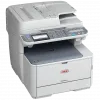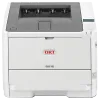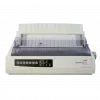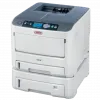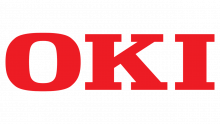
Oki Electric Industry Co., Ltd. (沖電気工業株式会社, Oki Denki Kōgyō Kabushiki-gaisha) (TYO: 6703), commonly referred to as OKI, OKI Electric or the OKI Group, is a Japanese company manufacturing and selling info-telecom and printer products. Headquartered in Tokyo, Japan, OKI operates in over 120 countries around the world.
OKI manufactured the first telephone in Japan in 1881, and now, after more than 120 years the company specializes not only in developing and manufacturing telecommunication equipment but also in information products and mechatronics products, such as Automated teller machine(ATMs) and printers. Its printer business is operated through OKI Data, under the brand name, OKI Printing Solutions. OKI had a semiconductor business, in which it spun-off and sold to Rohm Co., Ltd., on October 1, 2008.
OKI provides products to telecom carriers, financial institutions, government agencies, large corporation as well as SMBs both directly and via distributors and dealers.
OKI of telecommunication (1881–1950s)
Founding
Kibataro Oki (1848–1906) is the founder of today’s OKI. In January 1881, with his enterprising spirit, Kibataro convinced that the nation was about to enter the age of communications, and founded Meikosha, the origins of today's OKI. The company manufactured the first telephone in Japan in 1881, only five years after Alexander Graham Bell invented the phone.
Early years
OKI contributed immensely to the spread of phones in Japan under the country’s Telephone Expansion Plans. The company not only focused on telephones, but saw the need of automatic exchanges as phones became more common.
Pre and post wars
During World War I, wartime demand brought large profits to OKI as demand for telephone service increased. A strong demand emerged for PBXs (Private Branch Exchange) and at that time, OKI installed the largest PBX system in Japan. In addition to business from Japan, overseas business also grew, providing railroad-type printers, portable telephones and electric wires outside of Japan. From around 1920, OKI achieved notable advances in its technical development of common-battery switchboard.
In the late 1930’s, OKI’s plants were used towards meeting the military demand for goods having a major influence on OKI’s business. Based on this demand, OKI built new production plants, increased its capital and increased the number of its affiliate
Though OKI increased its production capacity after the war to restore magnetotype telephones and exchanges that were damaged during the war, OKI endured great difficulties as it moved toward rebuilding itself. In November 1, 1949, Oki Electric Industry Co., Ltd. (today’s OKI) was established to replace the former Oki Electric Co., Ltd. And the two years later in November 1951, OKI’s shares were listed on the Tokyo Stock Exchange. It was also at this time when OKI started mass producing the “Type-4 telephone,” which was called the “symbol of Japan’s postwar reconstruction. OKI was also aware of learning new telecommunication technologies, and in 1956, it was the first to produce an 100-line Ericsson-type crossbar-switching systems for commercial use.
OKI of electronics (1960s -1980s)
OKI gradually transformed itself into an electronics company from the second half of 1960s into the 1970s.
1960s
To respond to the high-level economic growth Japan was experiencing, OKI needed to speed up its business operations and clarify responsibilities. OKI began producing and supplying high-quality business machines such as Teletypewriter, and perforation typewriters. In June 1961, OKI launched OKITYPER2000, an electric teletypewriter that could simultaneously make perforation tapes and book entry forms. The company also developed and sold various general-purpose computers such as OKITAC-5090, the first domestically produced computer to use core memory.
In 1964 OKI developed OKISAVER, a terminal for online deposits which were provided to financial institution.
1970s
In addition to minicomputers such as OKITAC series developed in the mid 1960s, OKI began supplying various I/O devices, electroprinters, and dot printers, mainly to the financial industry in the 1970s. OKI’s business at this time included cash dispensers(CDs), automatic depositors(ADs) and automated teller machines (ATMs).
It was at this time when OKI expanded its overseas business providing telecommunication systems to countries in the Middle East, Central and South American countries as well as other Asian countries. In 1972, OKI established Oki Data Corporation (ODC: today’s OKI Data Americas), a Japan-US joint venture in New York, to develop the DP100, dot printers.
Around that time in 1975, OKI developed the world’s first automobile telephone system together with Bell Labs. This was the beginning of OKI’s wireless technology, and today (as of 2009) OKI expands this technology into vehicle-to-vehicle communications and other ETC (Electronic toll collection) technologies.
1980s
In May 1980, OKI launched its if800 series, which was a successful business-use PC business. It also added a facsimile business unit to develop private sector demand. . In 1982, OKI introduced the world’s first cash-recycling ATM, allowing deposited banknotes to be immediately used for withdrawal.
OKI of network solutions (1990s)
In the early 90s, Japanese economy was in the midst of recession that continued after the bubble economy collapsed, which also hit a strong blow to OKI’s business. In October 1994, OKI spun off its printer and facsimile business, and established Oki Data Corporation. In the later 90’s, with the spread of Internet, OKI worked on being recognized as the company that offers network solutions
2000 and beyond
As Internet changed the conventional structures of lives, OKI aimed to become the key player to realize a so-called “e-Society full of Ubiquitous Services,” contributing in developing infrastructures and products to enable individuals to access service, whenever, wherever, and with whatever.
In 2004, OKI released its IP CONVERGENCE Server SS9100, the industry’s first Microsoft.Net-compliant server, and in 2006, released its Center Stage NX5000, a carrier-grade communication server compliant with next-generation networks.
In 2008, as part of its business selection and concentration measures, OKI spun off its semiconductor business to Rohm Co., Ltd.
